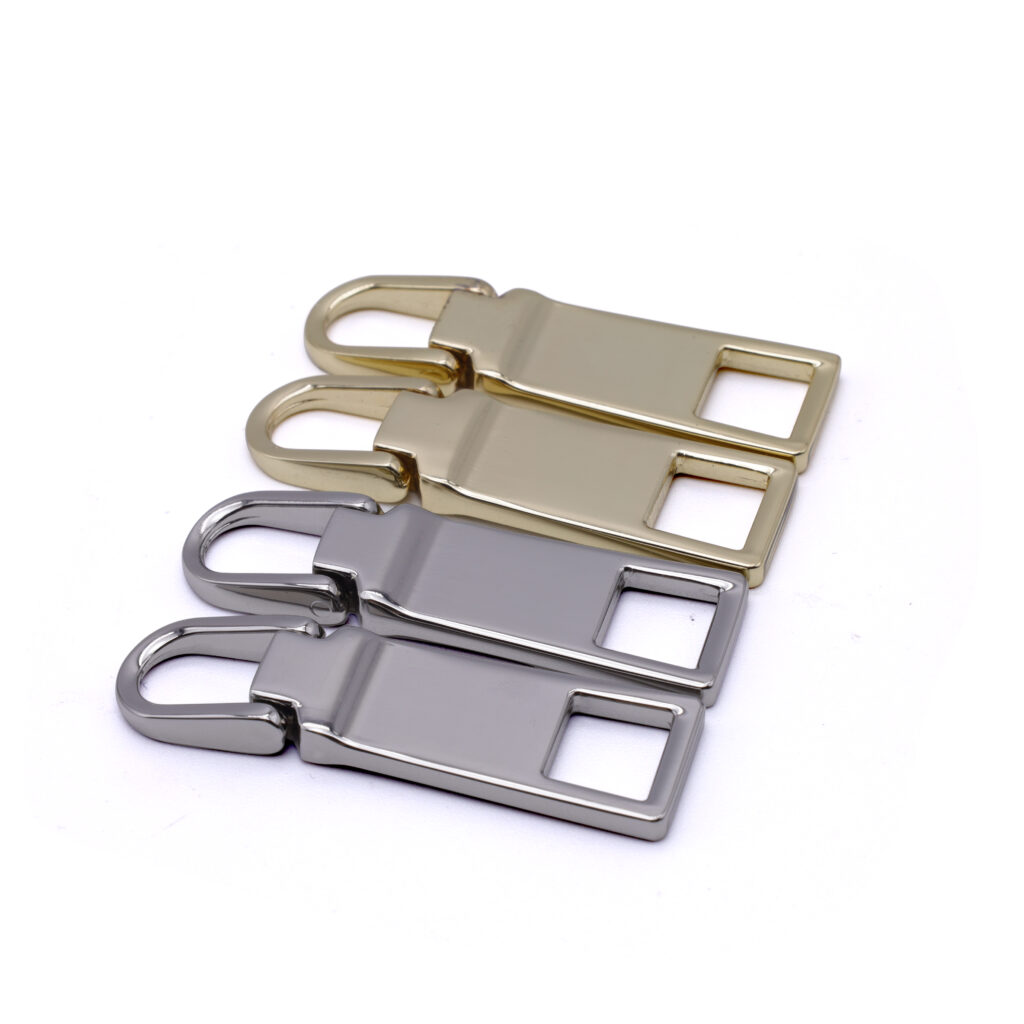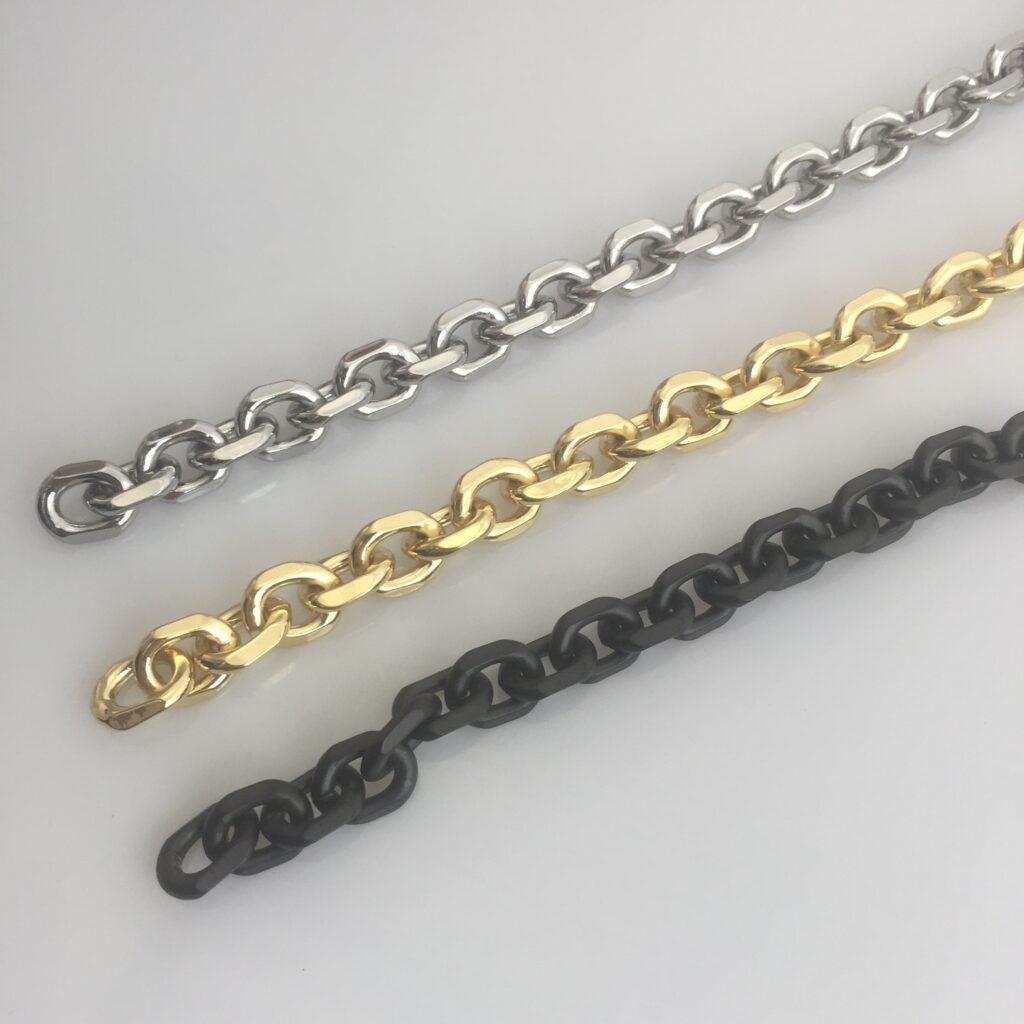
-
Material Classification of Zipper Pulls
The material of a zipper pull determines its durability, texture, and appearance. Common materials include:
- Metal Zipper Pulls
– Zinc Alloy: The most common metal zipper pull material, cost-effective, and can be electroplated in various colors (gold, silver, black). Widely used in mid-to-high-end luggage.
– Copper: Used in premium luggage, offering a solid feel and high wear resistance, but more expensive. Common in luxury or vintage-style bags.
– Stainless Steel: Excellent rust resistance, suitable for outdoor or humid environments, but heavier.
– Aluminum Alloy: Lightweight design, often used in travel suitcases and sports backpacks, with anodized surface treatments for different colors.
- Plastic Zipper Pulls
– ABS Plastic: High hardness, good plasticity, and available in various shapes and colors. Commonly used in casual backpacks and children’s luggage.
– Nylon: Lightweight and wear-resistant, but less premium in texture than metal, mostly used in budget-friendly bags.
- Composite Material Zipper Pulls
– Metal + Plastic Combination: Combines aesthetics and lightweight properties (e.g., metal pull tab with plastic base).
– Rubber-Coated Metal: Improves grip and tactile feel, often seen in sports backpacks.
-
Surface Treatment Processes for Zipper Pulls
The surface treatment affects both appearance and durability:
- Plating Processes
– Nickel Plating: Silver-white, highly rust-resistant, the most common plating method.
– Chrome Plating: Mirror-like finish with high gloss but prone to fingerprints.
– Gold/Rose Gold Plating: Enhances luxury appeal, often used in high-end luggage.
– Black Nickel/Gunmetal Plating: Dark gray or black, suitable for business or outdoor styles.
– Antique Copper/Distressed Finish: Used in vintage-style luggage for a retro look.
- Coating Processes
– Standard Paint: Customizable colors but may wear off over time.
– Rubber Paint: Provides a non-slip grip, common in sports backpacks.
– Metallic Powder Coating: Improves wear resistance while maintaining a metallic look.
- Other Processes
– Anodizing (common for aluminum alloy zipper pulls): Forms an oxide layer for better corrosion resistance.
– Laser Engraving: Allows branding or custom patterns.
– Brushed Finish: Creates a textured metallic surface for enhanced aesthetics.
-
Common Types of Zipper Pulls
Different luggage types require different zipper pull designs:
- By Shape
– Standard: The most common type, suitable for most luggage.
– Low-Profile: Reduces friction, ideal for travel suitcases and lightweight backpacks.
– Large Pull Tab: Easier to grip, often used in outdoor backpacks.
- By Function
– Self-Locking Pulls: Feature a locking mechanism to prevent accidental sliding (e.g., YKK’s Auto-Lock technology).
– Dual-Pull Design: Allows opening from both ends, common in suitcases and large backpacks.
– Waterproof Pulls: Used with waterproof zippers in outdoor gear.
- By Brand
– YKK: Industry leader, known for reliability, preferred in high-end luggage.
– SBS: A quality Chinese brand offering good value.
– RIRI: Swiss luxury brand used in premium luggage.
– KEE: A well-known domestic brand catering to mid-range markets.
-
How to Choose High-Quality Zipper Pulls?
- 1. Check the Material
– For premium luggage, choose copper or zinc alloy for better durability.
– For lightweight needs, opt for aluminum alloy or plastic.
- Inspect Plating/Coating Quality
– High-quality pulls have even plating without bubbles, scratches, or peeling.
– Low-quality pulls may discolor or rust easily.
- Consider the Brand
– International brands like YKK and RIRI offer superior reliability.
– Domestic brands like SBS and KEE provide good cost-performance ratios.
- Test Smoothness
– High-quality pulls glide smoothly without sticking.
– Poor-quality pulls may jam due to imprecise molding.
- Verify Locking Mechanism (if applicable)
– Self-locking pulls should stay securely in place.
-
Maintenance and Care for Zipper Pulls
- Regular Cleaning: Wipe with a soft cloth to prevent dust buildup.
- Avoid Excessive Force: Prevents deformation or breakage.
- Prevent Moisture & Corrosion: Metal pulls can rust in humid conditions—apply light oil for protection.
- Replace Damaged Pulls: If a pull is broken, replace it promptly to avoid further issues.
Future Trends
Lightweight Designs: Increased use of aluminum alloy and high-strength plastics.
Smart Features: Integration of RFID anti-theft tech or electronic sensors.
Eco-Friendly Materials: Nickel-free plating and biodegradable plastics.
Customization: Laser engraving and color personalization to meet consumer demands.
Conclusion
Though small, zipper pulls are crucial to luggage functionality. Understanding their materials, treatments, and selection criteria helps consumers choose durable products and assists manufacturers in optimizing designs. Future advancements will focus on lighter, smarter, and more sustainable zipper pulls.


